On this page
- Chickens - broilers/roasters
- Electrical stunning
- Waterbath stunning
- Waterbath single phase stunner
- Plate or grid systems for electrical stunning of birds
- Two phase two plate electrical multiple bird stunner
- Head-only electrical stunning
- Recommended parameters for electrical stunning methods
- Controlled atmospheric stunning (CAS)
- Low atmospheric pressure systems (LAPS)
- Captive-bolt stunning
- Specific poultry class or species requirements for stunning methods
- Mature chickens
- Rock Cornish hens
- Turkeys
- Geese
- Ducks
- Silkies and farmed game birds: quail, partridges, pheasants
- Ratites (ostriches, rhea and emus)
- Bleeding /sticking
Chickens -broilers/roasters
Electrical stunning
Multiple bird electrical stunning systems - operational procedures and parameters
For most electrical multiple bird stunning systems, the birds are shackled inverted when still conscious prior to stunning; therefore shackling must be done in a manner to minimize distress and pain to the birds.
Shackles, shackling, shackle line, fractures, bruising and breast bars
- Birds must be lifted and shackled by both legs.
- Aquatic birds (geese and ducks) require extra care and body support as they are picked up and shackled by both legs because of anatomical differences in where the legs are positioned on the body compared to other poultry.
- Birds weighing 15 kg or more should have more support until they are shackled for humane handling.
- All birds and especially turkeys and geese, should only be suspended on the shackle line for a minimum amount of time since the stressful and potentially painful effect of shackling is dependent on its duration.
- Injured and sick birds should not be shackled but rather, humanely killed as soon as possible.
- However, birds require approximately 12 seconds to stop wing flapping after hanging; this may be because they are entering into a state of tonic immobility (a fear response).
- There should be some type of breast bar, support or comforter that maintains contact with the bird's front as this has a calming effect prior to stunning.
- Shackle lines that operate smoothly with few abrupt changes in direction are more conducive to keeping the birds calmer.
- If shackles are too large there will be poor electrical contact and insufficient current flow and this could become a welfare issue for undersized birds especially (inadequate stun)
- Shackles are designed for the birds slaughtered; larger size birds will experience pain due to leg nociceptors if the legs are forced into shackles too small for the leg diameter.

Description for chicken handling/shackling
Firstly
A chicken is shown extensive leg and wing bruising from injuries probably sustained from handling/shackling; then
A chicken shackle is shown; thirdly,
The shackling step of poultry is demonstrated and lastly
Shackled conscious chickens are shown.
Source: CFIA and Food and Agriculture Organization of the UN (FAO)
Conductivity
- A saline solution/ (brine) that contain 0.1% Salt (NaCl2) is 1000 times more conductive than pure water and approximately 35 times more conductive than typical municipal potable drinking water.
- Using a saline solution to reduce resistance and increase conductivity will help optimize current flow in a system that functions properly; but it will not substitute for a poorly functioning system.
- A saline solution concentration between 0.1% and 1% is ideal to improve electrical conductivity for most waterbath systems.
- Consult the manufacturer of the equipment to determine if additional salinity is required for effective functioning of the waterbath stunning equipment.
- Thick keratinized or scaly skin and feathers are poor conductors of electricity.
- Some birds, including those that are mature and those that are dehydrated have reduced conductivity.
- An increase in temperature of the saline solution will decrease the resistance.
| Weight (g of salt/liter) | ppm (mg/L) | Conductivity (H2O and NaCl) |
|---|---|---|
| 0.0001 | 1 | 2.2 |
| 0.001 | 10 | 21.4 |
| Example, Saskatoon Drinking Water | 27 | ≈ 57 |
| 0.01 | 100 | 210 |
| 0.1 Table Note 1 | 1000 | 1990 |
| 1.0 Table Note 2 | 10000 | 17600 |
Table Notes
- Table Note 1
-
Waterbath concentration
- Table Note 2
-
If you spray the shackles at 1 g/liter it will greatly increase conduction
Waterbath stunning
Waterbath single phase stunner
- This is a common type of multiple bird electrical stunning system in use for poultry world-wide.
- These are designed to produce a head-body stun; the circuit should go through the head, the body and is completed when it reaches the feet that contact the ground bar.
- The effectiveness of the stun is highly dependent on the electrical parameters used, the depth of the bird in the saline solution, in addition to other individual bird specific variables (resistance, size), all of which determine the resulting electrical pathway the circuit makes:
- birds with thick and dense bones are more likely to be inadequately stunned in a given lot of poultry, for example adult hen
- The current will flow in different proportions through different tissues, for example, the abdominal fat tissue has a higher resistance; therefore there is less current flow through this tissue; while more current will flow proportionally through breast muscles, heart and brain.
- Depending on all these variables, the electrical circuit may travel over the surface of the body, causing electro-immobilization, or it may travel through the body, including the heart causing stunning:
- the amount of current flowing through each bird depends on the current applied in the water bath, the number of birds and the resistance of each bird
- high frequency stunning reduces the depth and duration of the stun:
- even with a relatively strong stunning current passing through the body, including the heart, the majority of birds will be stunned without cardiac arrest, as the heart muscle is less sensitive to high frequency stunning; whereas with low frequency stunning using the same current, birds will be stunned and the majority will have cardiac fibrillation/arrest
- In addition, the total resistance to consider for setting parameters is actually the sum of the resistance of the birds and the resistance of the stunner itself:
- it is always more important to monitor the amperage rather than the voltage since electrical resistance of the circuits can vary between different slaughter establishments and within the same establishment as well
- resistance should be taken into account for determining the electrical parameters for each group of birds being stunned
- The waterbath must be sufficiently large (width, length and depth) to accommodate the wing span and body mass for the type of bird(s) being slaughtered and to avoid birds' heads or other parts being trapped outside of the waterbath sides.
- The water bath (live) electrode must be kept cleaned/ regularly cleaned and must run the entire length of the waterbath to facilitate current flow.
- The ground (if part of the shackle) electrode must be kept clean/regularly cleaned and have constant contact with the shackles (intermittent contact results in a poor intermittent stun).
- Continuous contact of the ground electrode can be achieved by passive pressure of the electrode against the shackles or by using two electrodes that trap the shackles.
- The height of the waterbath stunner and the amount (level) of saline solution or brine in the waterbath stunner should be adjusted throughout the day as needed to ensure even the smallest birds are submerged up to their shoulders.
- There should be adequate access to the stunning equipment.
- The output of the electrical equipment (volts or amps) should be tested under load, using equipment which can simulate the resistance of a shackled bird (1200 - 2300 Ohms) or a bird's head (300 - 400 Ohms), depending on the placement of the electrodes.
- Do not use a live bird to test the equipment.
- Regardless of the line speed the birds must be submerged in the saline solution or brine and be stunned for sufficient time so that they remain insensible until they have been bled and died of exsanguination.
- The electrical settings must be appropriate for the largest and smallest birds in the flock.
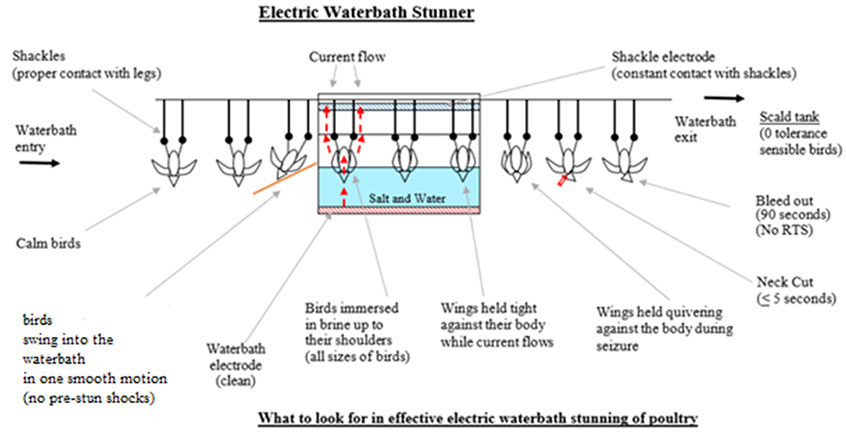
Description for Diagram of a single phase electric waterbath stunner
Important elements of an electrical waterbath stunning system and equipment are described for this type of stunner and include the following steps:
- the shackles for the legs of the bird are clean to make the best contact with the legs
- the presence of an entry ramp allows each bird to swing into the bath better
- the bird is immersed up to the shoulders to ensure good contact with the electrified water for the stun which will cause a seizure when done correctly
- the ground electrode is in constant contact with the shackles to complete the electrical circuit
- the bird is bled soon after exiting the stunning equipment
- the birds bleeds within 90 seconds so no conscious bird enters the scald tank
Source: CFIA and Humane Slaughter Association
Entry to a waterbath stunner
Pre-stun shocks:
- occur when the bird's wing(s) or head (often the beak) receive an electrical shock prior to the animal being electrically stunned
- responses vary depending on which part of the body was shocked:
- they include; sudden wing flapping, raising their head and neck, as well as sudden vocalization
Pre-stun shocks are not acceptable and are caused by:
- no entry ramp, water overflowing from the waterbath stunner, the shackle line descends at the approach to the waterbath stunner such that the wings (especially geese and turkeys) make contact with the water before their heads
- no entry ramp, descent of the shackle line is so gradual that bird's head (often the beak) slowly come in contact with the water causing them to have repeated shocks and to withdraw their heads until they are sufficiently submerged to be stunned
- entry ramp, not electrically isolated from the waterbath stunner
- entry ramp, electrified waterbath water overflows onto the entry ramp
- flapping wings come in contact with the sides of the waterbath stunner (therefore requires sufficiently large waterbath and calm birds that don't flap their wings)
Minimize pre-stun shocks by:
- no water over flow at the entrance of the electrical waterbath stunner
- entry ramp to the waterbath stunner that is electrically isolated from the stunner (electrical current cannot flow from the stunner to the entry ramp)
- this can be achieved by placing an insulating material between the stunner and the entry ramp, or covering the entry ramp with a material that acts as an insulator (does not conduct current)
- use an inclined flat ramp at the entrance to the waterbath stunner
- design the shackle line such that the birds are drawn up the entry ramp by the shackle line:
- the head and body of the bird then swings gently into the waterbath and are quickly submerged in the electrified saline solution up to the base of their wings (shoulders) in one smooth movement
- this results in the bird's head and wings entering the water together and the bird is stunned immediately
- waterbath stunner sufficiently large to accommodate the wing span of the birds being slaughtered
Wing flapping is caused by:
- bright lights, unexpected loud noises, jolts or turns in the shackle line, tight fitting shackles, stressed birds (from being inverted and shackled)
Wing flapping can be significantly reduced by:
- type of breast bar, support or comforter
- low light levels or blue light in the lairage and shackling area
- calm quiet lairage and shackling area
- using the correct size of shackles:
- for example, should not use chicken shackles for turkeys as they are small, will cause increased pain for turkeys which results in wing flapping
- ensuring there are no sudden dips, turns or jolts in the line
- time for birds to settle between shackling and the waterbath:
- 12 seconds is considered a best practice
Plate or grid systems for electrical stunning of birds
Other multiple bird systems include single plate (grid) and two phase (step) plate (grid) systems:
- these use the principles of an electrified wet or dry plate making contact with the head of the bird rather than the bird's body submerged in saline water up to the shoulders
- these produce a head-only or head-body stun
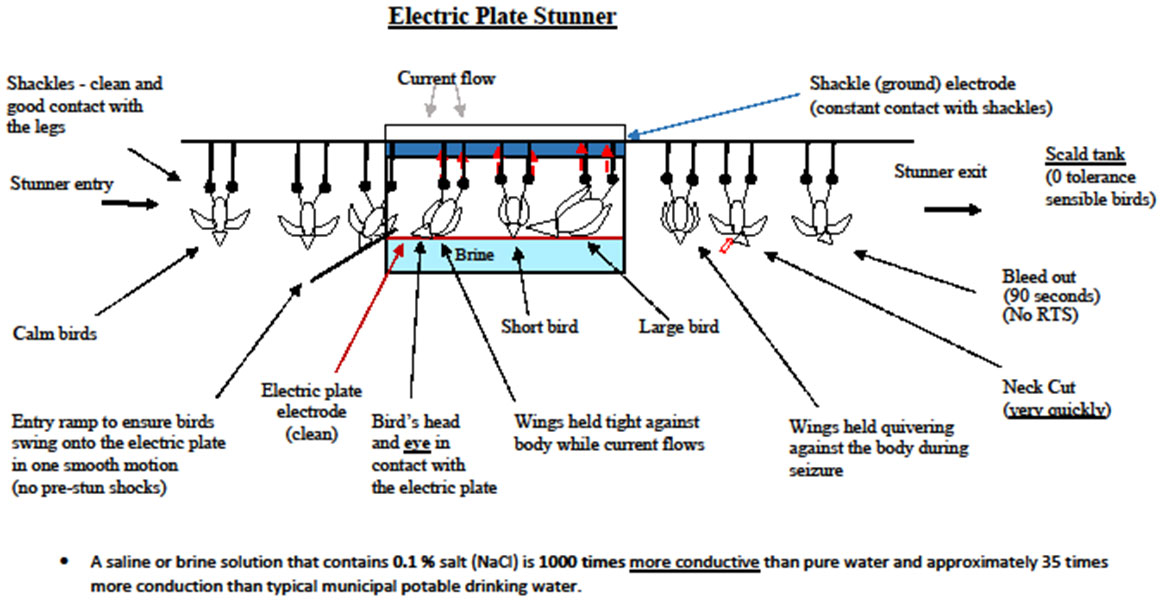
Description for Diagram of an electric wet plate single phase stunner
Key elements of an electric plate single phase stunner system and equipment are described in the diagram of this type of stunner and include the following key steps for proper stunning:
- the shackles for the legs of the bird are clean to ensure the best contact with the legs
- the presence of an entry ramp allows each bird to swing into the bath better
- the bird’s head and eye make contact with the electrified plate for the stun which will cause a seizure when done correctly
- the equipment can adjust for short and large birds
- the ground electrode is in constant contact with the shackles to complete the electrical circuit
- the bird is bled soon after exiting the stunning equipment
- the birds bleeds within 90 seconds so no conscious bird enters the scald tank
Source: CFIA and Humane Slaughter Association
Two phase two plate electrical multiple bird stunner
- An example of a multiple bird two phase plate or grid system in use presently in North America is a low voltage DC and AC two phase plate system.
- Any low voltage stunners (AC /or DC) carries the increased animal welfare risk that it only immobilizes birds if the resulting current generated by the low voltage is not high enough to induce an epileptiform seizure:
- this is because the threshold current necessary to induce immediate loss of consciousness is more than that required for production of seizures/convulsions or loss of reflexes (in other word, signs resembling effective stun)
- Birds that are electro-immobilized are paralyzed yet fully conscious and look the same as those that are effectively stunned; therefore evaluating unconsciousness may be difficult with this system.
- The potential outcome with a low voltage system is that the lower the voltage the more likely the bulk of the current will be conducted on the surface of the animal's body (resulting in an electro- immobilization) as opposed to through (within) the animal's body; the latter circuit is more likely to achieve an effective stun.
- When using this system, there should be sufficient evidence of effectiveness to demonstrate that the low voltage stunner effectively stuns the animal (such as induces an epileptiform seizure):
- the result is that the animal remains insensible until it is dead from exsanguination
- Each section (AC and DC) should be supplied with sufficient current to render the bird insensible (neither section must immobilize the birds).
- The ground bar must come in contact with all shackles over the AC and DC sections.

Description for Diagram of an example of a two plate system
Elements of the two sections of an electric plate two phase stunner system are described in the diagram of an example of a two plate system and include the following steps: the bird enters the first step or the Direct Current phase for this wet plate section and then enters the second step or the Alternating Current phase for this dry plate section in order to complete the stunning process.
Source: CFIA
| Outcome | Parameters to include in preventive measures |
|---|---|
Generalized epileptiform seizure
|
Minimum current amperage, voltage, frequency, duration of stun Maximum shackle duration, stun-to-stick interval Frequency of calibration of equipment Prevention of pre-shocks Immersion of birds up to base of wings |
Based on Welfare of Poultry at Slaughter Workshop, Mohan Raj
Head-Only electrical stunning
Hand-held head-only electrical stunning
This type of electrical stunning device is often used for small birds, culls, or in plants using very slow line speeds.
Tongs or similar device
To ensure adequate current flow, the electrodes of the tongs or the device must:
- Be cleaned regularly to minimize resistance
- Make good contact with the skin,
- Be positioned on each side of the head midway between the eye and the ear so that they span the brain, and
- Never be placed across the neck as it can cause paralysis while the bird remains conscious and able to feel pain.
If not done properly the birds may have electrically induced seizures or be electrically immobilized without losing sensibility and be able to feel pain.
Target location for hand-held device placement (Figure a)
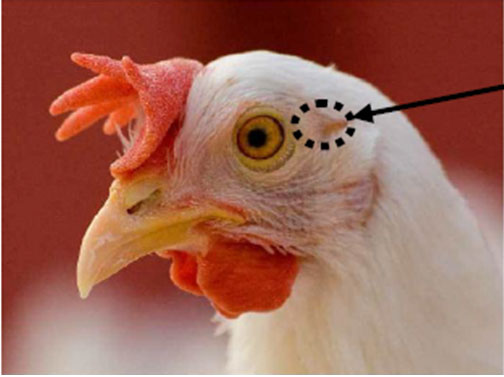

Brain
Located in the centre of the head (skull), medial to and just behind the eyes.
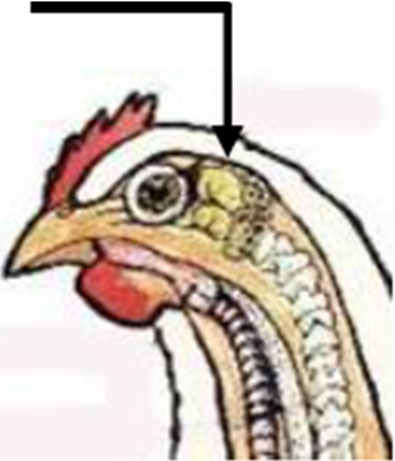
Stunning
- Approach the bird's head from the top.
- The bird's head is inserted into the stunning device.
- To be effective the electrodes must span the brain.Should be at least 7-8 seconds
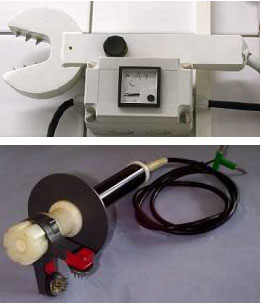
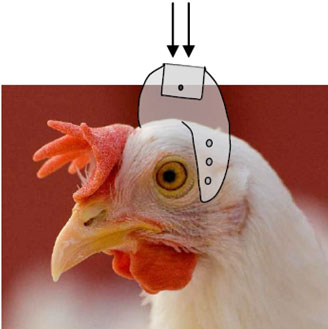
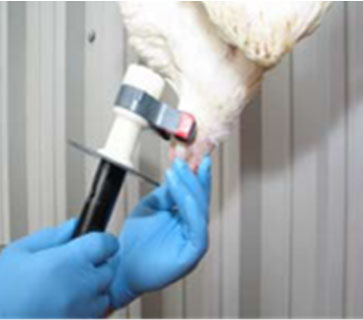
Source: Osten Johansson Maskinteknik Stinsgatan
Automated head-only electrical stunning
A current system for head-only automated electrical stunning uses an automated shackling process after stunning.
- this system uses the principle of individually stunning each bird with an automated head electrode placement
- it takes into account each bird's individual resistance, to provide more accurate electrical parameters per bird
- this helps to overcome the challenges of customizing electrical stunning for the individual bird, which are difficult to achieve with multiple bird electrical stunning systems
Key operational points
- each bird's individual resistance determines the proper required current that is capable of producing effective individual stun
- there is no water required for the head-only stunning
- the bird's legs are shackled automatically after stunning in one of the systems
- birds not stunned effectively are identified and can then be removed from the shackle line for restunning
- the stunning parameters are also individually recorded, are thereby documented evidence of effectiveness for monitoring, verification and auditing purposes
- slaughter without stunning of individual birds is possible with this system because the individual restraining cones allow the heads of each bird to be positioned for the ritual cut


| Outcome | Parameter to include in preventive measures |
|---|---|
| Generalized epilepiform seizure, reversible stunning | Minimum current, voltage, frequency, duration of stun Maximum stun-to-stick interval Frequency of calibration of equipment Prevention of pre-stun shocks Position and contact surface area of the electrodes |
Based on Welfare of Poultry at Slaughter Workshop, Mohan Raj
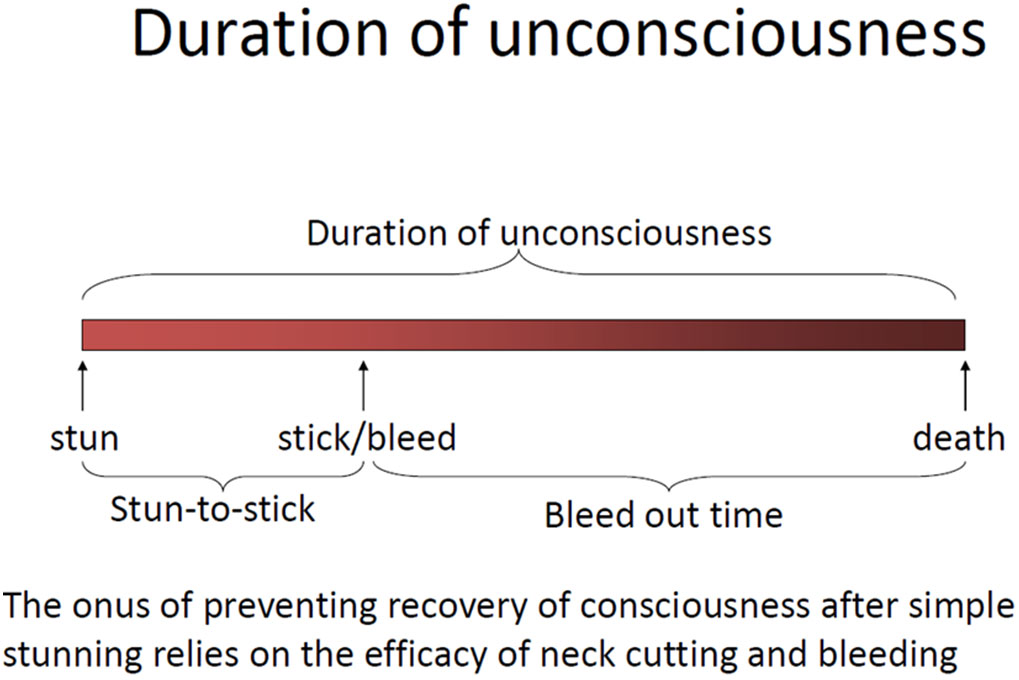
Description for Diagram of stun to stick requirements for reversible (simple) stunning parameters
Diagram of time interval of unconsciousness relative to stun to stick timing for reversible stunning of all food animals during slaughter that shows the ideal time to bleed the animal after the stun to ensure the animal remains unconsciousness until it dies from the bleeding slaughter step.
Source: Mohan Raj, Welfare of Poultry at Slaughter Workshop
Recommended parameters for electrical stunning methods
Tables of electrical waterbath stunning parameters for poultry in accordance with World Organisation for Animal Health (WOAH; founded as Office International des Épizooties (OIE)) recommendations
| Species | Minimum current (milliamperes per bird) |
|---|---|
| Broilers | 100 |
| Layers (spent hens) | 100 |
| Turkeys | 150 |
| Ducks and geese | 130 |
| Frequency (Hz) | Minimum current (milliamperes per bird) | |
|---|---|---|
| Chickens | Turkeys | |
| From 50 to 200 Hz | 100 mA | 250 mA |
| From 200 to 400 Hz | 150 mA | 400 mA |
| From 400 to 1500 Hz | 200 mA | 400 mA |
| Frequency (Hz) | Chickens | Turkeys | Ducks; geese | Quails |
|---|---|---|---|---|
| < 200 | 100 mA | 250 mA | 130 mA | 45 mA |
| 200 - 400 | 150 mA | 400 mA | Not permitted | Not permitted |
| 400 - 1500 | 200 mA | 400 mA | Not permitted | Not permitted |
| Chicken | Turkeys |
|---|---|
| 240 mA | 400 mA |
Based on Mohan Raj, Welfare of Poultry at Slaughter Workshop
Controlled atmosphere stunning (CAS)
- To fully optimize the animal welfare advantages of this type of stunning method, the newer gas systems incorporate the crate in which the birds are placed at the farm and then the same crates are used as part of the transportation and stunning system:
- The animal welfare advantage includes that the conscious birds are minimally handled; the birds are handled only when first caught on the grow-out farm and placed into the crates, either manually or mechanically (mechanical bird catchers)
- Birds that have died prior to the stunning-slaughter steps are to be detected and removed either before or after gas stunning as long as these carcasses do not enter the food chain and compromise food safety.
- The method chosen to detect the dead birds must be shown by science based evidence to be effective; it must be reliable and reproducible.
CAS systems using different mixtures of CO2, Argon and O2
- The types of gases used, the concentrations of gases used and the rate of descent into the gas chamber should not be aversive or stressful or cause the bird avoidable suffering.
- Concentration of gases, dwell times or decompression times must be sufficient to stun or kill the birds regardless of the line speed.
- Variation of gas concentrations and total dwell time both depend on class of poultry stunned, weight, species and whether the outcome is a reversible or irreversible stun.
- CAS systems in Canada generally use:
- CO2 in air; increasing the levels of CO2 progressively until the birds become unconsciousness, either reversibly or irreversibly or
- CO2 with O2; increasing the levels of CO2 progressively and removing the O2 until the birds become unconsciousness, generally irreversibly.
- High concentrations of CO2 can irritate the mucous membranes upon contact and cause aversive behaviours in birds:
- therefore it is important to monitor the birds during induction for aversive behaviour and implement the necessary correction action procedures to prevent this behaviour from recurring
- the CO2 gas quality must meet internationally accepted standards
- The gas temperature must be maintained in accordance with manufacturer's specifications
| Gas mixtures (examples) | Induction phase | Final phase |
|---|---|---|
| CO2 with air | 30% - 40% | 60% - 100% CO2 |
| CO2 with O2 | 40% maximum + 30% enriched O2 (gradually removed in multiple stages) | > 40% (in multiple steps) + removed O2 |
| Argon, nitrogen (or other inert gases) with air | 90% Argon with air Residual O2 does not exceed 2% |
No change |
| CO2 and Argon (or any other inert gas mixture in air) | 30% CO2 and 60% Argon with air Residual O2 does not exceed 2% |
No change |
Low atmospheric pressure systems (LAPS)
- Birds are less inclined to suffer from the undesirable side-effect of trapped gases in the abdomen compared to mammals because of their different respiratory system anatomy.
- According to European Union legislation, current systems are to apply to broiler chickens weighing 4 kg or less for the present time; however it has been used for irreversible stunning in the USA for layer and breeder chickens, turkeys and quail.
- Key parameters (EU 2018/723, amending annexes I and II of EU regulation 1099/2009) to consider:
- Rate of pressure reduction to remove O2 to less than 5% in two phases:
- phase 1 - pressure reduction from 760 Torr to 250 Torr (standard sea level atmospheric pressure) for a minimum of 50 seconds
- phase 2 - 160 Torr (standard sea level atmospheric pressure) within 210 seconds
- duration of exposure
- ambient temperature and humidity (LAPS decreases the ambient humidity)
- Rate of pressure reduction to remove O2 to less than 5% in two phases:
Modules with birds loaded into cyclinders (Source: TechnoCatch LAPS)
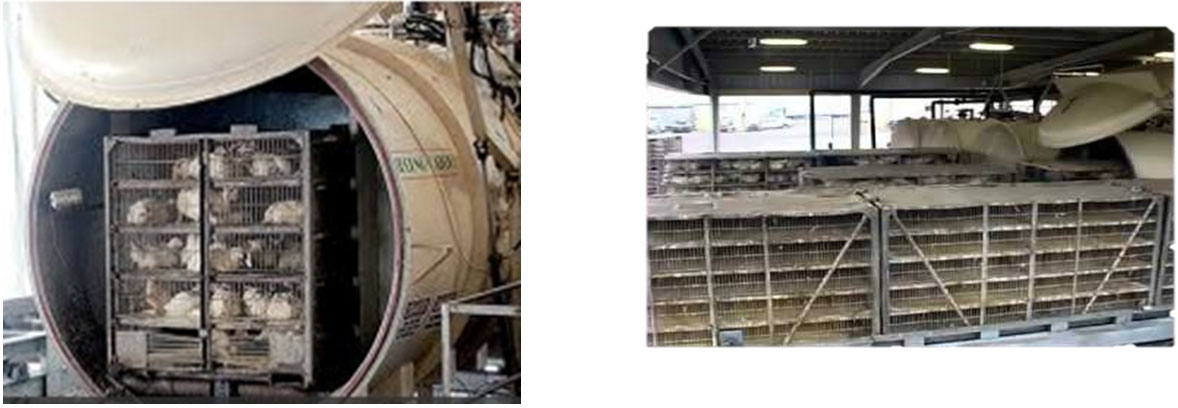
Decompression cylinders (Source: TechnoCatch LAPS)

Captive bolt stunning
Maintenance and operational issues for maximum effectiveness
- Reduced velocity due to friction caused by carbon deposits can reduce velocity by up to 50%.
- Failure for bolt to retract completely will reduce bolt velocity due to the increased size of the expansion chamber.
- Sporadic use of the device causes greater build-up of carbon deposits than continued use for a similar number of shots.
- Clean and test daily but do not test on a live bird.
- There are devices that are cartridge powered while others use compressed air.
Target location for captive bolt stunning

Brain
Located in the centre of the bird's head (skull), medial to and just behind the eyes.
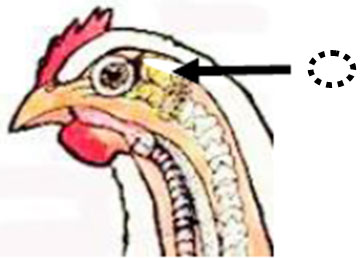
Source: CFIA
Stunning
- Approach the bird's head from the top.
- Point and discharge the captive bolt stunning device directly at the centre of the top of the birds head, medial to and just behind the eyes.
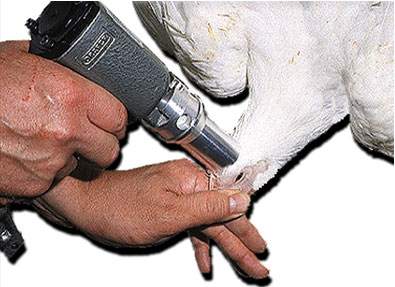
Specific poultry class or species requirements for stunning methods
Mature chickens (culled breeders, end-of-lay broilers, end-of-lay laying hens)
Handling and/or stunning requirements unique to this class of chickens
Handle gently and support calcium depleted animals with fragile skeletons that fracture easily. Skeleton fragility is exacerbated by the lack of muscle conditioning from being housed in small cages for several months.
Electrical stunning
- there are increased voltage requirements due to bird size and increased resistance caused by dry scaly legs
- see broilers for details
Captive bolt stunning
- see broilers for detail
Controlled atmosphere stunning (CO2)
- less handling of birds with fragile skeletons if birds remain in crates or drawers
- see broilers for details
Rock Cornish Hens (immature broilers)
Handling and/or stunning requirements unique to this class of chickens
Electrical stunning
- these birds have significantly smaller bodies and are shorter than typical broilers
- ensure all birds are immersed in the saline solution up to their shoulders (wings)
- the diameter of rock Cornish hen's legs are less than that of broilers
- smaller shackles may be required to make adequate contact with the bird's legs to ensure the electric current flows through their body properly
- placing both legs together in a single slot of a chicken shackle is not acceptable
- another option may be to apply a 0.1% or 1% saline solution to the shackles and legs to increase the conductivity
Captive bolt stunning
- use a poultry length bolt
- the landmarks and approach are the same as for broilers
- additional safety precautions may be required due to the smaller head
Controlled atmospheric stunning (CO2)
- is effective
- methods and precautions are similar to broilers
Turkeys
Electrical stunning
- unless the operator can demonstrate they are effective and humane, low voltage stunning devices are not permitted
- in general turkeys require 150 mA to be properly stunned (WOAH)
- high frequency stunning devices usually require an increase in current to effectively and humanely stun turkeys
- review the electrical stunner manual provided by the manufacturer before operating to be familiar with the type of stunning equipment and the normal electrical settings for the various sizes of birds
Waterbath stunning
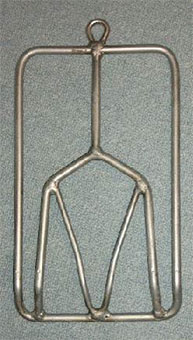
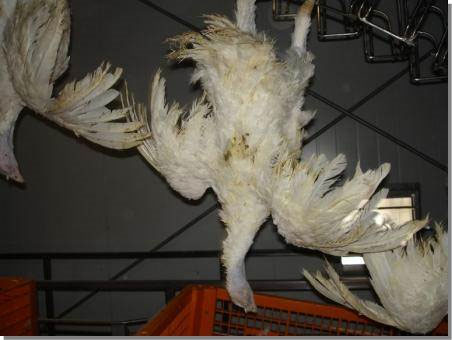

- turkeys have larger legs and longer wing spans than chickens therefore they require larger shackles and greater spacing between birds on the line as well as surrounding structures and equipment
- do not use chicken shackles
- breast bars prior to stunning help calm turkeys and facilitate a quiet entry into the waterbath stunner
Resistance and current to each bird
- turkeys have larger legs and longer wing spans than chickens therefore they require larger shackles and greater spacing between birds on the line as well as surrounding structures and equipment
- do not use chicken shackles
- breast bars prior to stunning help calm turkeys and facilitate a quiet entry into the waterbath stunner
Resistance and current to each bird
- turkeys have a greater body mass and are older than chickens at the time of slaughter
- larger birds with greater body mass and older birds (particularly hens) with dry and scaly legs results in increased resistance and reduced conductance of current
Entry to the water bath stunner
- greater wing span increases the likelihood of pre-stun shocks on entry into the waterbath stunner
- the entry ramp and approach of the shackle line to the waterbath stunner must be appropriate for turkeys
Head-only electrical stunning
- this type of electrical stunning device is often used for cull birds, or in plants using very slow line speed
- see section on broilers for details
Brain
Located in the centre of the head (skull) medial to and just behind the eyes.
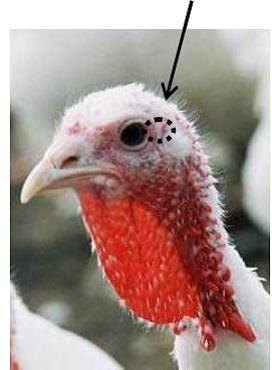 Source: Aviagen Turkeys Ltd
Source: Aviagen Turkeys Ltd
Direct the stunning device at a location that is just behind the eyes and just forward (rostral) to the ear openings.
Approach the bird's head from the top.
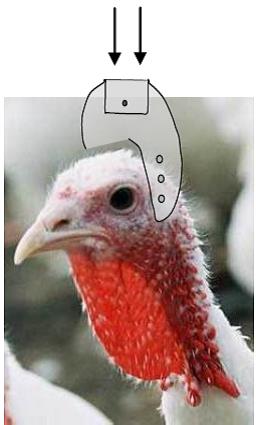
Source: Aviagen Turkeys Ltd and CFIA
Controlled atmospheric stunning (CO2)
- See the section for stunning and handling procedures for broilers
Captive bolt stunning
- Is important in the humane stunning of mature birds
- See head only electrical stunning of turkeys for landmarks

Source: Humane Slaughter Association
Geese
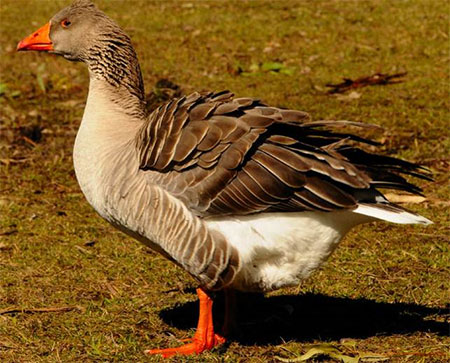
Electrical stunning
Waterbath electrical stunning
- in general geese require 130 mA to be properly stunned in a waterbath stunner (WOAH)
- geese are large birds with longer bodies, long necks and long wing spans
- geese are aquatic birds:
- their bodies float on water
- they submerge their head in water to feed
- they are familiar with water and raising their heads above water to breath
- when an effort is made to stun them they frequently raise their heads and necks out of the saline solution making stunning them effectively in waterbath stunners particularly difficult
- ensure their body, neck and heads are continuously submerged up to their shoulders like chickens, or waterbath stunning will be unsuccessful and inhumane
- the entry ramp and descent of the shackling line to the waterbath stunner must be such that the bird's wings do not come in contact with the waterbath stunner or before the bird's head and body is submerged in the saline solution
- see the section on chickens for details
Head-only electrical stunning
- geese require 400 mA for when stunned using a head-only electrical stunner (WOAH)
- see details in the section for chickens
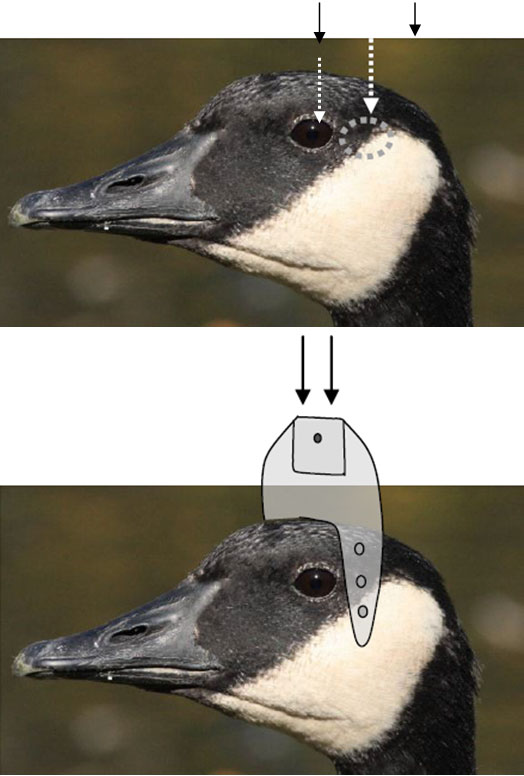
Source: CFIA
Controlled atmosphere stunning (CO2)
- geese are aquatic birds:
- they have evolved to hold their breath and feed underwater for prolonged periods of time
- In doing so they are exposed to higher blood levels of CO2
- if CO2 is used to stun geese the operator will need to ensure the birds are submerged in the gas mixture for a sufficiently long period of time to induce unconsciousness and a lack of sensibility
- neck cutting must occur immediately after stunning
- monitoring return to sensibility should be designed for geese and ensure there is no return to consciousness and sensibility before death
- see the section on broiler chickens for details
Captive-bolt stunning
- restrain the bird
- restrain the head of the bird by holding the beak
- place the muzzle of the stunner on the highest point of the head, on the midline with the captive-bolt aimed straight down through the head
- discharge the device
- see the section on broiler chickens for details

Source: Humane Slaughter Association (HSA) and CFIA
Ducks
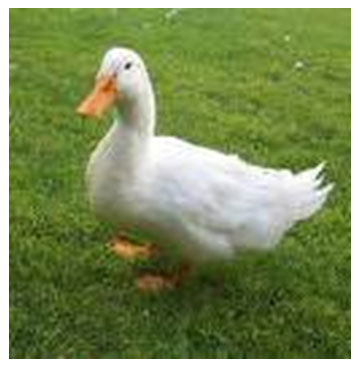
Electrical stunning
Waterbath stunning
- in general ducks require 130 mA to be properly stunned in a waterbath stunner (in accordance with WOAH recommendations)
- ducks have long necks and long wing spans
- ducks are aquatic birds:
- their bodies float on water
- they submerge their head in water to feed
- they are familiar with water and raising their heads above water to breath
- when an effort is made to stun them in waterbath stunners they do not necessarily submerge in the water as easily as do running birds (chickens and turkeys) and they frequently raise their heads out of the saline solution making stunning them effectively in waterbath stunners particularly difficult
- stunning is ineffective when their heads and necks are raised
- ensure their body, neck and heads are continuously submerged up to their shoulders like chickens, or waterbath stunning will be ineffective and inhumane
- the entry ramp and descent of the shackling line to the waterbath stunner must be such that the bird's wings do not come in contact with the waterbath stunner, or before the bird's head and body is submerged in the saline solution
Head only electrical stunning
- similar to geese
- see details in the section for broilers
Controlled atmosphere stunning (CO2)
- ducks are aquatic birds that have evolved for diving and holding their breath for prolonged periods of time while they feed or escape potential predators underwater
- ducks have evolved to survive and remain conscious with very high levels of blood CO2
- the gas stunning program must be designed for ducks
- if COs is used to stun ducks the operator will need to ensure the birds are submerged in the gas mixture for a sufficiently long period of time to induce unconsciousness and a lack of sensibility
- neck cutting must occur immediately after stunning to avoid a return to sensibility
- monitoring return to sensibility should be designed for ducks and ensure there is no return to consciousness and sensibility before death
- see details in the section for broilers
Captive bolt stunning
- similar to geese
- see details in the section for broilers
Silkies and farmed game birds: Quail, Partridges, Pheasants

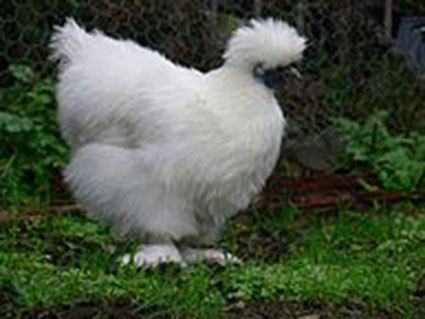
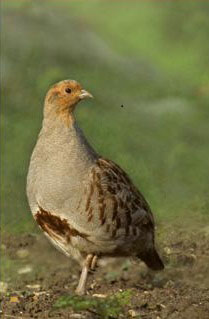

Electrical stunning
- either electrical waterbath stunning or electric plate stunning are used for these birds
- for low production volume establishments, individual bird may be stunned with head-only electrodes:
- the electrodes must span the brain
- amperage must be sufficient to effectively stun the bird
- the small size of quail in particular makes them fragile and special care with shackle design is required to avoid breaking the legs:
- placing both legs together in a single slot of a chicken shackle is not acceptable
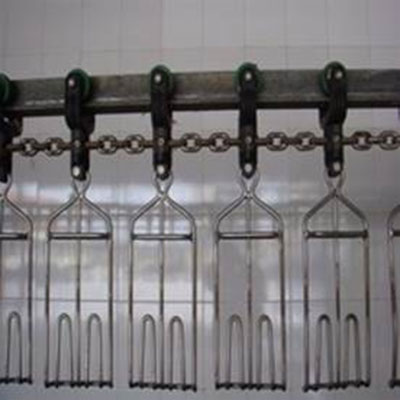

Controlled atmosphere stunning (CAS)
- methods for broilers for CAS of the birds in the crates can be adapted for these species of bird
- CAS reduces the animal welfare risks associated with handling them
- the gas and temperature parameters must be set to effectively and humanely stun the birds
Ratites (Ostriches, Rhea and Emus)
Mechanical
Landmarks and approaches
- ratite heads are very small for mechanical stunning
- top of the head at the midpoint of an imaginary line between the outer ear openings:
[a]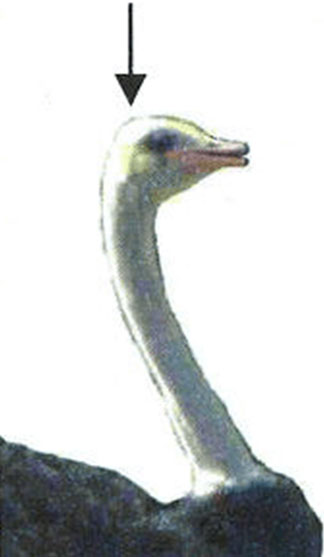
| Image | Description |
|---|---|
 |
indicates the direction that the stunning device should be pointed and the entry point at the top of the animal's head |
Mechanical stunning devices
Captive bolt
- a captive bolt device may be used if the stunner operator uses the appropriate sized stunning device and the appropriate charge
- to prevent perforation, use a very short bolt and small charge (see below)
Recommended captive bolt equipment
- ratites: short bolt and smallest charge appropriate for poultry or rabbits
Firearms
- do not use firearms to stun ratites due to the small head, thin frontal bone (0.5 - 1.0 mm) and risk of perforation
- perforation occurs when the projectile exits from the opposite side of the skull from the entry point
Electrical Stunning
Landmarks and approaches
- both sides of the head behind the eyes and just over the outer ear openings
- use tongs that facilitate grabbing both sides of the head. The current flows from one side of the head to the other
[b]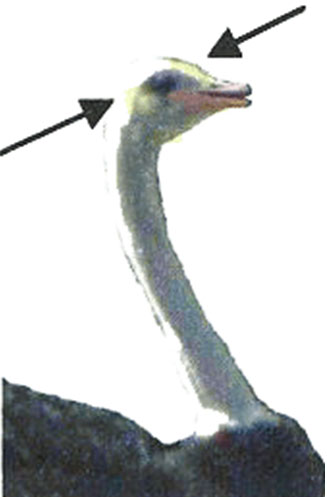
| Image | Description |
|---|---|
 |
Indicates where the electrodes should be applied to each side of the animal's head. |
Electrical stunning devices
| Birds | Amperage | Volts | Frequency | Time (sec) |
|---|---|---|---|---|
| Ostriches, Rhea, Emus | Not hooded 0.12 - 0.4 | 230 - 300 | 50 - 60 | 3 - 4 |
| Ostriches, Rhea, Emus | Hooded 0.4 | 230 - 300 | 50 - 60 | 3 - 4 |
Shackling and hoisting
- shackling occurs either before or after stunning; the shackle may be placed on the legs but no hoisting or inversion is permitted until the animal has been effectively stunned
- hoisting occurs after the stun has been completed
Sticking
- head-only stunning, animals regain sensibility quickly; therefore, stun to stick interval must be ≤ 15 seconds
- stick the animal as soon as it has been stunned
- the sticking options include a complete ventral cut of the neck (both carotids) below the head, or at the thoracic inlet
Neck cutting and bleeding
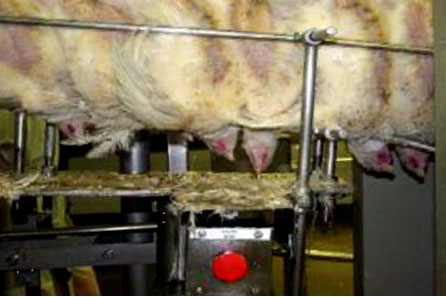
Source: Food and Agriculture Association (FAO)
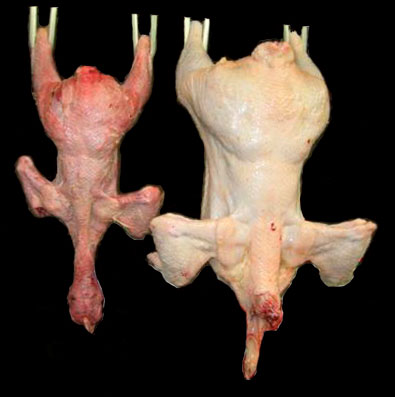

Source: CFIA
"Red" not bled bird compared to normal neck cut bled bird (Figure 1) and "Red" bird with neck not cut (figure 2)
Note: red birds are generally the smallest birds or the runts in a given lot of birds
- Neck cutters must be adjusted for variations in sizes (lengths) of birds to ensure the carotids and jugular veins are cut at the attachment of the head to the neck.
- Birds smaller (shorter) may not have their necks cut, will not bleed out and will return to sensibility
Bleeding /sticking
- within 15 seconds for low frequency stunning (50 Hz)
- within 10 seconds for high frequency stunning (> 500 Hz)
- time is calculated from the moment the bird exits the waterbath stunner or the hand-held electrical stunner is lifted from the birds head
- backup neck cutter is required for birds that are not properly cut (or decapitate)
- at least one carotid artery and jugular vein must be cut, cutting both carotids is preferable
- birds should be bled for at least 90 seconds before further processing or entering the scald tank
- monitor neck cutting and return to sensibility
- under production conditions signs of return to sensibility can be expected 30-45 seconds post electric stun unless the bird is bled out
- all birds must remain insensible until they are dead
- birds must be cut, adequately bled and dead before they enter the scald tank
- there is zero tolerance for birds showing signs of recovery when they reach the scald tank
| Stunning method | Maximum stun-to-cut interval |
|---|---|
| Electrical methods and non-penetrating captive bolt | 10 - 15 seconds |
| CO2 | 60 seconds after leaving the chamber |
(Based on WOAH guidelines)